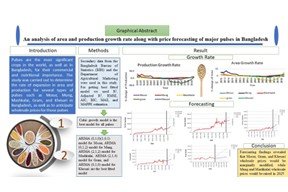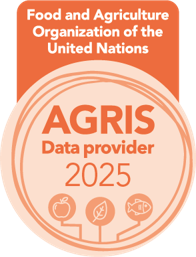An analysis of area and production growth rate along with price forecasting of major pulses in Bangladesh
Abstract
Pulses are the most significant crops in the world, as well as in Bangladesh, for their commer-cial and nutritional importance. The study was carried out to determine the rate of expansion in area and production for several types of pulses such as Mosur, Mung, Mashkalai, Gram, and Khesari in Bangladesh, as well as to anticipate wholesale prices for those pulses. Secondary data from the Bangladesh Bureau of Statistics (BBS) and the Department of Agricultural Marketing were used in this study. Following a diagnostic check, such as R2, Adjusted R2, RMSE, AIC, BIC, MAE, and MAPPE, it was discovered that the Cubic growth model was the best for specified pulses. The data over the entire time revealed that total output in the area rose in the case of all pulses. Mosur and Mung had positive average production growth rates of 2.02 and 6.919 percent, respectively. Mashkalai, Gram, and Khesari experienced negative growth rates of -0.541, -8.894, and -0.854 percent, respectively. After computing the average percentage change for Area growth rate Mosur, Mung, and Mashkalai showed positive growth rates of 1.229, 4.631, and 1.152 percent, respectively. In contrast, Gram and Khesari both had negative average values of -7.719 and -1.987 percent. This study applied the ARIMA (0,1,0) (1,0,1) model for Mosur, ARIMA (0,1,2) model for Mung, ARIMA (2,1,2) model for Mashkalai, ARIMA (2,1,4) model for Gram, and ARIMA (0,1,0) model for Khesari since those models passed the diagnostic test. Forecasting findings revealed that Mosur, Gram, and Khesari wholesale prices would be marginally modified, while Mung and Mashkalai wholesale prices would be raised in 2025. Thus, analyzing the growth rates of area and output of key pulses may help farmers allocate their land more wisely and price forecasts will help farmers in identifying the best crops for their production, which will improve the output of these crops in Bangladesh.
Keywords:
ARIMA, Forecast, Growth rate, Pulses, Wholesale priceDownloads
References
BBS (2020). Ministry of Planning, Government of the Peoples’ Republic of Bangladesh, Dhaka, Bangladesh.
Bhuiyan, M. (2019). Measurement of growth rate, instability, and forecasting of AUS rice production in Bangladesh. Bulgarian Journal of Agricultural Science 33, 85–92.
Box, G. E., & Jenkins, G. M. (1976). Time series analysis: Forecasting and control San Francisco. Calif: Holden-Day.
Crops (2019). Classification of Crops, https://thefactfactor.com/facts/ pure _ science /biology/crops/2082/
DAM (2021). Department of Agricultural Marketing, http:// www.dam.gov.bd/price_graphical_report
Das, S., & Kabir, W. (2016). Pulses production in Bangladesh: status and drivers for enhancement. F1000Research, 5.
Devegowda, S. R., Singh, O. P., & Kumari, K. (2018). Growth performance of pulses in India. The Pharma Innovation Journal, 7(11), 394-399.
Dhakre, D. S., & Sharma, A. (2010). Growth analysis of area, production and productivity of maize in Nagaland. Agricultural Science Digest, 30(2), 142-147.
FAO (2019). The Global Economy of Pulses.
FAO (2021). World Food and Agriculture - Statistical Yearbook 2021. Rome.
Gujarati, D. N. (2003). Basic econometrics. Prentice Hall.
Hajong, P., Rahman, H. M., Kobir, M. S., & Paul, S. (2020). Production and value chain analysis of lentil in some selected areas of Bangladesh. International Journal of Sustainable Agricultural Research, 7(4), 234-243.
Merga, B., & Haji, J. (2019). Economic importance of chickpea: Production, value, and world trade. Cogent Food & Agriculture, 5(1), 1615718.
Neill, A. O. (2020). Share of economic sectors in the GDP in Bangladesh, https://www.statista.com/statistics/438359/share-of-economic-sectors-in-the-gdp-in-bangladesh/
Peixeiro, M. (2019). The complete guide to time series analysis and forecasting understands moving average, exponential smoothing, stationarity, autocor-relation, SARIMA, and apply these techniques in two projects.
Population (2022). Bangladesh Population 2022, https://world population review.com/countries/Bangladesh-population
Rahman, N. M., & Baten, M. (2016). Forecasting area and production of black gram pulse in Bangladesh using ARIMA models. Pakistan Journal of Agricultural Sciences, 53(4).
Shahbandeh, M. (2020). Production volume of pulses worldwide from 2010 to 2020, Statista. https://www.statista.com/statistics/721945/pulses-production-volume-worldwide/
Tularam, G. A., & Saeed, T. (2016). Oil-price forecasting based on various univariate time-series models. American Journal of Operations Research, 6(3), 226-235.
Uddin, M. T., Hossain, M. K., & Ullah, M. O. (2015). Growth and instability in area and production of pulse in Bangladesh. Journal of Agricultural Science and Engineering, 1(4), 63-67.

Published
How to Cite
Issue
Section
Copyright (c) 2023 Agriculture and Environmental Science Academy

This work is licensed under a Creative Commons Attribution-NonCommercial 4.0 International License.

